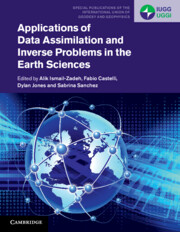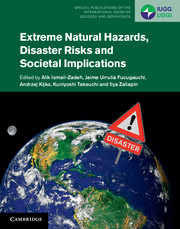56 results
19 - Data Assimilation in Geodynamics: Methods and Applications
- from Part III - ‘Solid’ Earth Applications: From the Surface to the Core
-
-
- Book:
- Applications of Data Assimilation and Inverse Problems in the Earth Sciences
- Published online:
- 20 June 2023
- Print publication:
- 06 July 2023, pp 293-310
-
- Chapter
- Export citation
Acknowledgements
-
- Book:
- Applications of Data Assimilation and Inverse Problems in the Earth Sciences
- Published online:
- 20 June 2023
- Print publication:
- 06 July 2023, pp x-x
-
- Chapter
- Export citation
Part III - ‘Solid’ Earth Applications: From the Surface to the Core
-
- Book:
- Applications of Data Assimilation and Inverse Problems in the Earth Sciences
- Published online:
- 20 June 2023
- Print publication:
- 06 July 2023, pp 173-355
-
- Chapter
- Export citation
Part I - Introduction
-
- Book:
- Applications of Data Assimilation and Inverse Problems in the Earth Sciences
- Published online:
- 20 June 2023
- Print publication:
- 06 July 2023, pp 1-76
-
- Chapter
- Export citation
Contributors
-
- Book:
- Applications of Data Assimilation and Inverse Problems in the Earth Sciences
- Published online:
- 20 June 2023
- Print publication:
- 06 July 2023, pp vii-viii
-
- Chapter
- Export citation
1 - Inverse Problems and Data Assimilation in Earth Sciences
- from Part I - Introduction
-
-
- Book:
- Applications of Data Assimilation and Inverse Problems in the Earth Sciences
- Published online:
- 20 June 2023
- Print publication:
- 06 July 2023, pp 3-8
-
- Chapter
-
- You have access
- HTML
- Export citation
Part II - ‘Fluid’ Earth Applications: From the Surface to the Space
-
- Book:
- Applications of Data Assimilation and Inverse Problems in the Earth Sciences
- Published online:
- 20 June 2023
- Print publication:
- 06 July 2023, pp 77-172
-
- Chapter
- Export citation
Index
-
- Book:
- Applications of Data Assimilation and Inverse Problems in the Earth Sciences
- Published online:
- 20 June 2023
- Print publication:
- 06 July 2023, pp 356-358
-
- Chapter
- Export citation
Copyright page
-
- Book:
- Applications of Data Assimilation and Inverse Problems in the Earth Sciences
- Published online:
- 20 June 2023
- Print publication:
- 06 July 2023, pp iv-iv
-
- Chapter
- Export citation
Contents
-
- Book:
- Applications of Data Assimilation and Inverse Problems in the Earth Sciences
- Published online:
- 20 June 2023
- Print publication:
- 06 July 2023, pp v-vi
-
- Chapter
- Export citation
12 - Inverse Problems in Lava Dynamics
- from Part III - ‘Solid’ Earth Applications: From the Surface to the Core
-
-
- Book:
- Applications of Data Assimilation and Inverse Problems in the Earth Sciences
- Published online:
- 20 June 2023
- Print publication:
- 06 July 2023, pp 196-208
-
- Chapter
- Export citation
7.6 - Appendix: Multivariate 1D-VAR Assimilation with an Adjoint
- from 7 - Data Assimilation in Hydrological Sciences
-
- Book:
- Applications of Data Assimilation and Inverse Problems in the Earth Sciences
- Published online:
- 20 June 2023
- Print publication:
- 06 July 2023, pp 124-130
-
- Chapter
- Export citation
Preface
-
- Book:
- Applications of Data Assimilation and Inverse Problems in the Earth Sciences
- Published online:
- 20 June 2023
- Print publication:
- 06 July 2023, pp ix-ix
-
- Chapter
- Export citation

Applications of Data Assimilation and Inverse Problems in the Earth Sciences
-
- Published online:
- 20 June 2023
- Print publication:
- 06 July 2023
26 - Geohazard Analysis for Disaster Risk Reduction and Sustainability
- from Part VII - Future Earth and Risk, Safety and Security
-
-
- Book:
- Global Change and Future Earth
- Published online:
- 22 October 2018
- Print publication:
- 18 October 2018, pp 349-363
-
- Chapter
- Export citation
Part VII - Disaster risks and societal implications
-
- Book:
- Extreme Natural Hazards, Disaster Risks and Societal Implications
- Published online:
- 05 May 2014
- Print publication:
- 17 April 2014, pp 331-398
-
- Chapter
- Export citation
Acknowledgments
-
- Book:
- Extreme Natural Hazards, Disaster Risks and Societal Implications
- Published online:
- 05 May 2014
- Print publication:
- 17 April 2014, pp viii-ix
-
- Chapter
- Export citation
Part III - Case studies: Latin America and the Caribbean region
-
- Book:
- Extreme Natural Hazards, Disaster Risks and Societal Implications
- Published online:
- 05 May 2014
- Print publication:
- 17 April 2014, pp 143-166
-
- Chapter
- Export citation

Extreme Natural Hazards, Disaster Risks and Societal Implications
-
- Published online:
- 05 May 2014
- Print publication:
- 17 April 2014
1 - Extreme natural hazards and societal implications – the ENHANS project
- from Part I - Introduction
-
-
- Book:
- Extreme Natural Hazards, Disaster Risks and Societal Implications
- Published online:
- 05 May 2014
- Print publication:
- 17 April 2014, pp 3-14
-
- Chapter
- Export citation



